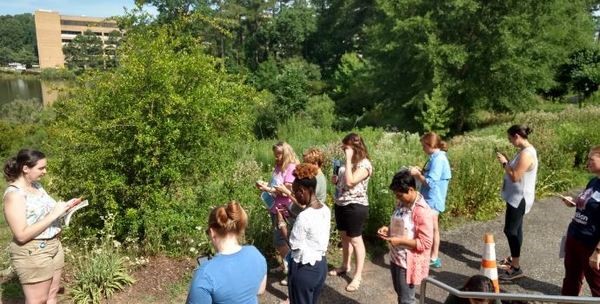Using EnviroAtlas to Empower Decision-Makers of Today and Tomorrow
Published February 26, 2019

EPA’s mission is to protect human health and the environment. Education, both formal and informal, plays a role in carrying out that mission. Environmental education helps individuals, communities, and organizations develop skills to investigate their environment, and increases public awareness and knowledge about environmental issues or problems. In doing so, it provides the public with the necessary skills to make informed decisions and take responsible action. Furthermore, a growing body of research shows that time spent in green spaces can benefit mental and physical health, in addition to supporting concentration and well-being in students. Using EPA’s EnviroAtlas, researchers designed a suite of educational materials to engage with state-of-the-art technology while exploring connections between the environment, the services that it naturally provides, and human well-being. EnviroAtlas is a web-based interactive mapping tool, containing hundreds of geospatial data layers, built-in analysis tools, and a wealth of other resources, that allows users to explore their surrounding environment. While some geospatial tools can require technical knowledge or expensive software packages to use, EnviroAtlas was created with accessibility in mind, and is free to anyone with internet access.
The EnviroAtlas educational materials include three lesson plans with teacher guides, a set of six mini-lessons, and supplementary activities like worksheets and crossword puzzles. They use the online interactive map to explore ecosystem goods and services, or “nature’s benefits,” covering concepts like watersheds, making science-based decisions, place-based learning, and the connection between ecosystem function and human health.
To maximize their accessibility, the lesson plans contain adaptations for classrooms with or without internet access, as well as an appendix matching the concepts covered with corresponding state science standards. The “Exploring Your Watershed” lesson, for example, includes versions for Spanish-speaking and English as a Second Language (ESL) classes, and versions to accommodate different levels of reading and written direction for students and teachers alike.
Acknowledging that young people are using technology almost from day one, the lessons are designed in a blended learning format, which uses a combination of technology and hands-on activities to maximize student engagement and understanding. Each lesson plan contains three parts: a technology portion, an outdoor portion, and a hands-on modeling or exploratory portion.
Through their focus on environmental education, the lesson plans drive home the message that human well-being is intrinsically connected with the environment.
In “Building a Greenway: Case Study,” a lesson plan designed for secondary grades and higher, participants use maps and data to simulate community decision-making processes and consider the concerns of different stakeholders in urban planning.
“Connecting Ecosystems and Human Health” highlights the linkages even more personally, as participants create a tangible web displaying ways that elements of the natural environment are related to specific human health outcomes, like asthma or anxiety, that students might already be familiar with, all backed by peer-reviewed research. The “Connecting Ecosystems and Human Health” activity is also relevant to adults and has been used by the North Carolina Department of Air Quality to explore connections between air quality and human health.
Over 50 educators took part in the EnviroAtlas Educators Workshop series, which brought North Carolina STEM and environmental educators to EPA’s Research Triangle Park campus for trainings on the EnviroAtlas tools and resources, including the educational materials. Many of those teachers have further shared the skills and materials with other educators in their communities.
The EnviroAtlas educational materials are available online, along with YouTube videos demonstrating the three full lesson plans, extending the reach of the materials beyond North Carolina.
Feeling empowered to use the premade lesson plans, as well as to create novel methods of using EnviroAtlas in their classrooms, educators across the country have contacted the EnviroAtlas team. Educators have seen potential utility for using EnviroAtlas in lessons ranging from sustainability to geometry, and going forward in her new role as an EPA ORISE Research Participant, Hartley hopes to collaborate with educators on publishing additional EnviroAtlas lessons.
Through it all, Hartley’s hope is that the EnviroAtlas tool and accompanying environmental education materials will empower students and teachers alike by strengthening the understanding that people are connected to nature, not separate. As one student in urban North Carolina pointed out after participating in the Eco-Health Connection activity, “I didn’t realize that protecting the environment meant protecting the people that I love.”
Editor's note: This article originally appeared in EM Magazine, a copyrighted publication of the Air & Waste Management Association (www.awma.org).
